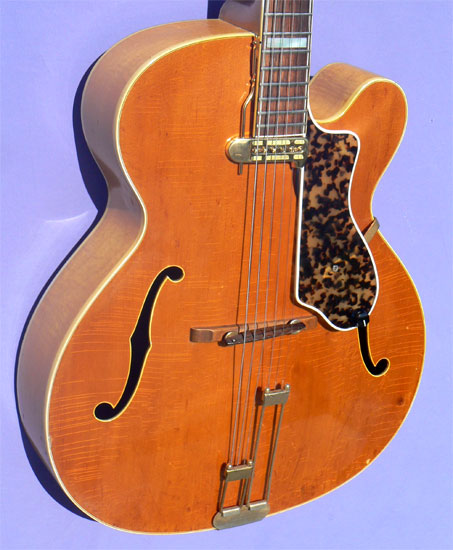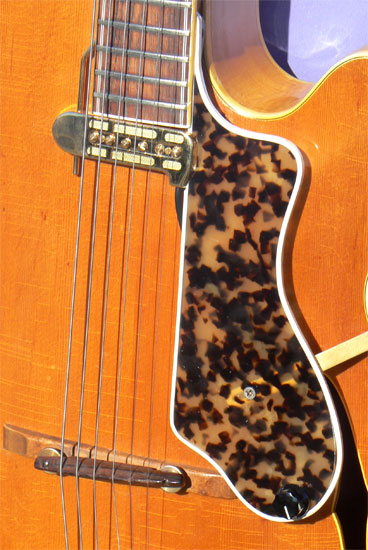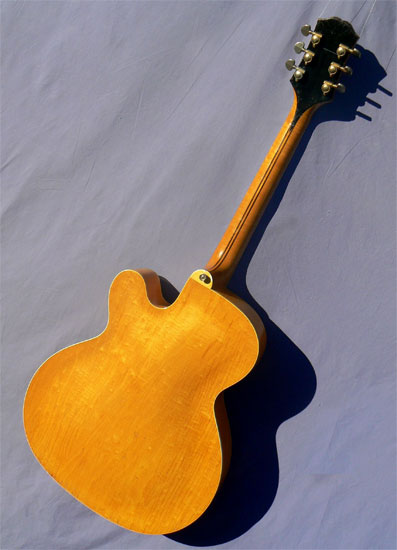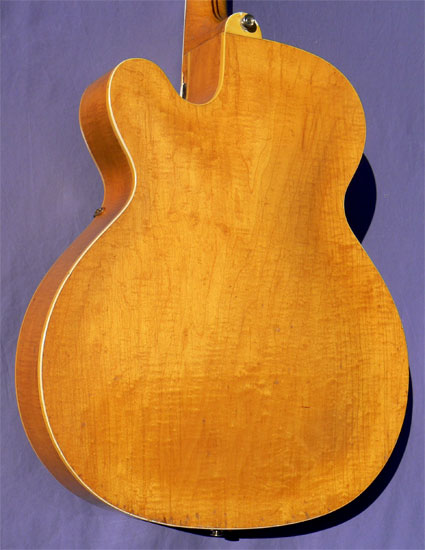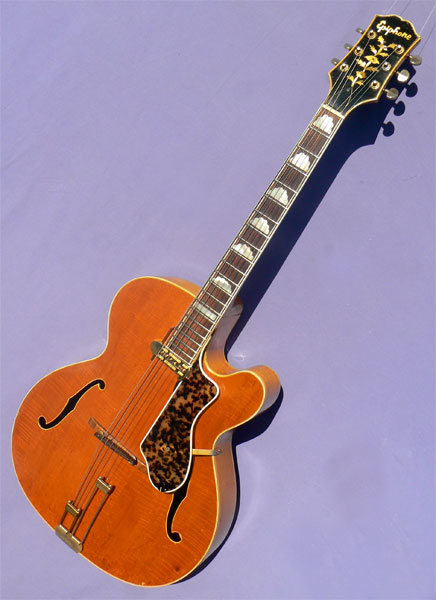 A-211N
A-211N
Home / Instruments /Accessories / Ordering / Tips / Friends
archtop.com
1959 Epiphone Deluxe Cutaway  A-211N
A-211N
Status: For pricing and hold status for this instrument, please check our Instruments page here. If this instrument does not appear on the Instruments page it has been sold, and is no longer available. Photos and descriptions of Previously Sold instruments may by found here. To be notified of examples of this or any other model in the future, please contact [email protected].
Serial #: A-2816, blue Kalamazoo label FON#: S8057-3
Body size at lower bout: 17 3/8" Scale length: 25 1/2" Nut width: 1 11/16" Neck depth: .86/1.10, 1st/10th fret
Finish: Original amber blonde finish, nitrocellulose lacquer type.
Materials: Solid carved Sitka spruce top; birdseye maple back and sides; solid maple neck with 5 piece center stripe; solid rosewood fingerboard with mother of pearl cloud inlay; rosewood/maple bridge, pearl tree-of-life peghead inlay, three-ply top and headstock binding, bound f-holes, neck and back; bone nut.
Hardware: Original gold hardware includes Pat. Pending Grover Rotomatic tuners, Frequensator tailpiece and pickguard bracket; adjustable truss rod, original medium jumbo frets. Vintage correct bound tortoise pickguard with recent DeArmond 1100 adjustable floating pickup, volume control, and endpin jack.
Notes: Fourteen. Total. So describes the entire number of the blonde Deluxe cutaways produced by Gibson during this model's fleeting eight year run. We all knew Deluxes were much rarer than their closest competitor, the Gibson L-5. And those seeking Deluxe styling in a cutaway guitar have discovered that these models are scarce to the vanishing point. But even we were surprised to learn just how few of these lovely creations rolled off the line in Kalamazoo.
For reasons unclear, Epiphone dawdled on regular production of cutaway guitars until the late 40's, leaving the field to Gibson for almost a decade. This inexplicable delay meant that Epiphone acoustic cutaways, especially the top-of-the line models, remain some of the rarest production archtops in the world. Having acquired the assets of their chief competitor in the late 50's, Gibson capitalized on Epiphone's peerless reputation by reviving Epi's carved archtop guitars at their Kalamazoo factory in 1959.
Crafted on the same production line as the L-5 and Super 400, the Deluxe Cutaway (model A-211N) was built in very small numbers by Gibson's top artisans using traditional Epiphone body specifications. Until it was discontinued in 1967, no more than three blonde Deluxe cutaways were produced in any given year, and several years saw none at all.
This remarkable example is one of just three from the very first year of Gibson production, and shows a number of unique features unseen on later models. Gibson's earliest Epis used up a handful of parts they acquired directly in the sale, and this guitar is fitted with the traditional style Frequensator tailpiece, an original Epiphone bridge, and an Epiphone Deluxe neck, hand inlaid with the traditional script logo and center-dip headstock, both later modified by Gibson designers. By contrast, the Pat. Pending Grover Rotomatic tuners are a distinctive Gibson touch, as seen on other of their high end models of the era.
The original multi-ply binding is all original and tight to the body, and the solid carved soundboard is constructed of exceptionally fine grained spruce, a remarkable 50-60 grains per inch at the outer margins. The generous Epiphone cutaway is 2 frets deeper than the L-5C, and allows unrestricted access to the uppermost reaches of the fingerboard. The neck has a fine full C profile, gently rounded and comfortable in the hand, and the original medium jumbo frets have sleek low action over a fresh high precision setup. Of particular note is the supremely comfy 10' radius fretboard (are you listening, modern builders?) a marvel of facility under the hand. Make no mistake, this is one of the smoothest playing vintage archtops we've seen here in awhile.
The instrument shows no apparent cracks or repairs, and little in the way of pick, buckle, thumb or fingerboard wear. Some scattered finish dings have had a bit of spot touchup, and some typical weather checking is visible in the deeply ambered original blonde finish. Finally, the instrument is fitted with a DeArmond 1100 adjustable floating pickup, on a vintage correct bound tortoise pickguard, with volume control and 1/4" endpin jack.
As one might expect, the voice of the guitar is notably warm, clear and open, a testament to its long career, with the punch and projection of a well played-in soundboard, with traditional parallel bracing. And the clouds, those lovely clouds, in the fingerboard. Impeccable in tone, elegant to play, and one of the handsomest pieces of history Gibson ever produced. One only: call now.
Setup: The frets have been precision leveled, recrowned and polished; trussrod tension and neck relief adjusted; bridge height adjusted; bridge compensation set; string slots at nut and bridge inspected and recut as necessary; bridge foot contour inspected and fit to top as necessary; bridge radius inspected and recurved as necessary; bridge wheels and tuners lubricated; fingerboard and bridge oiled; body and neck cleaned and hand polished.
This instrument is strung with medium gauge strings (.013). The guitar will accommodate lighter or heavier gauge strings, according to preference. String action is set at 4/64" to 5/64" at the 12th fret, with moderate relief for acoustic playing with medium strings. The action may be lowered or raised to your requirements with the adjustable bridge.
Case: Period arched black plush lined hardshell case.
